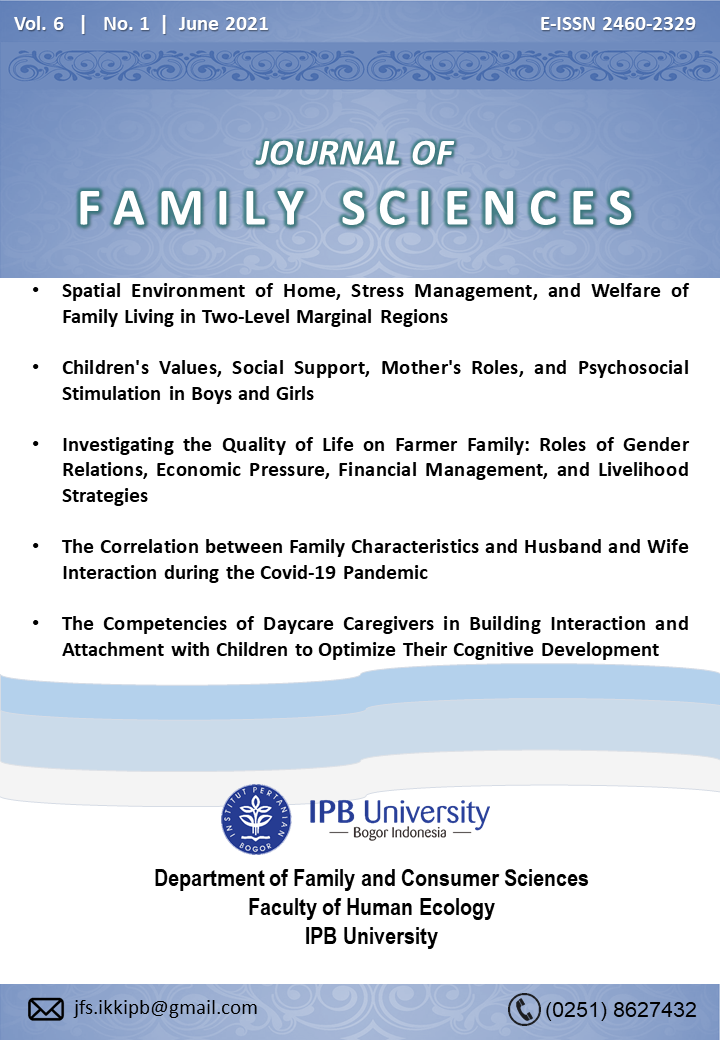Children's Values, Social Support, Mother's Roles, and Psychosocial Stimulation in Boys and Girls
Abstract
Psychosocial development is a developmental stage that every child will pass. This study aimed to analyze the influence of family and child characteristics, child value, social support, mother's involvement in psychosocial stimulation in boys and girls. The research design that was used in this study was a cross-sectional study. Site selection was chosen purposively, namely in the city of Medan. Research locations were in two villages, namely Kota Maksum, Medan Labuhan Subdistrict and Kota Besar Village, Medan Area District. The sample pulling technique uses simple random sampling with a sample of mothers who have children aged 2-3 years and come from a complete family of 150 people. Respondents interviewed with the questionnaire were mothers. Correlation test results showed a significant positive relationship between maternal age, children's values, dimensions of psychological value and dimensions of economic value, social support, dimensions of information support and dimensions of reward support, and mothers' role in care with psychosocial stimulation.
Downloads
References
Adicondro, N., & Purnamasari, A. (2012). Efikasi diri, dukungan sosial keluarga dan self regulated learning pada siswa kelas VIII. HUMANITAS: Indonesian Psychological Journal, 8(1), 17-27.
Aninda, R. N. (2013). Nilai anak perempuan pada keluarga batak ditinjau dari ibu dewasa awal dan dewasa madya. Jurnal Ilmiah Mahasiswa Universitas Surabaya, 2(1), 1-13. Retrieved from: http://journal.ubaya.ac.id/index.php/jimus/article/view/394/260
Armstrong, M. I., Birnie-Lefcovitch, S., & Ungar, M. T. (2005). Pathways between social support, family well being, quality of parenting, and child resilience: What we know. Journal of child and family studies, 14(2), 269-281. doi: 10.1007/s10826-005-5054-4
Bekteshi, V., & Kayser, K. (2013). When a mother has cancer: pathways to relational growth for mothers and daughters coping with cancer. Psycho‐Oncology, 22(10), 2379-2385. doi: https://doi.org/10.1002/pon.3299
Bradley, R., & Caldwell, B.M. (1984). Home observation for measurement of the environment (HOME)-revised edition. Amerika Serikat, US: University of Arkansas
Cahyani, P. B. (2009). Hubungan pengetahuan ibu dengan perkembangan motorik kasar anak usia 3-5 tahun di Boyolali [tesis]: Universitas Muhammadiyah Surakarta, Surakarta.
Caldwell, B., & Bradley, R. (1983). Home Observation for Measurement of The Environment (HOME) Inventory. Winsor Drive, Eau Claire. Lorraine Coulson HOME INVENTORY LLC.
Carolina, R. (2014). Optimalisasi tumbuh kembang anak dalam membangun pendidikan merupakan tanggung jawab orang tua. Jurnal Keluarga Sehat Sejahtera, 12(24).
Ceka, A., & Murati, R. (2016). The Role of Parents in the Education of Children. Journal of Education and Practice, 7(5), 61-64.
Croson, E., & Keim-Malpass, J. (2016). Grief and gracefulness regarding cancer experiences among young women. In Oncology nursing forum, 43(6):747–53. doi: 10.1188/16.ONF.747-753
Ermayanti, S., & Abdullah, S. M. (2007). Hubungan antara persepsi terhadap dukungan sosial dengan penyesuaian diri pada masa pensiun. Jurnal InSight. 5(148), 170.
Fazeli, E., Golmakani, N., Taghipour, A., & Shakeri, M. T. (2016). Intergenerational Comparison of Value of Children among Urban Women Population in Mashhad, Iran, 2014. Journal of Midwifery and Reproductive Health, 4(4), 732-740. doi: 10.22038/JMRH.2016.7306
Fisher, C., & O'Connor, M. (2012). "Motherhood" in the context of living with breast cancer. Cancer Nursing, 35(2), 157-163. doi: 10.1097/NCC.0b013e31821cadde
Friedman, M. M. (1998). Family nursing, theory and practice (3rd ed). Amerika serikat, US: Applenton & Lange.
Hartoyo. (1998). Investing in children: study of rural families in Indonesia. [dissertation]. Virginia Tech University. Blacksburg, Amerika Serikat
Hastuti, D. (2009). Stimulasi psikososial pada anak kelompok bermain dan pengaruhnya pada perkembangan motoric, kognitif, sosial emosi, dan oral/karakter anak. Jurnal Ilmu Keluarga & Konsumen, 2(1), 41-56. doi: 10.24156/jikk.2009.2.1.41.
Hastuti, D., Fiernanti, D. Y. I., & Guhardja, S. (2011). Kualitas lingkungan pengasuhan dan perkembangan sosial emosi anak usia balita di daerah rawan pangan. Jurnal Ilmu Keluarga dan Konsumen, 4(1), 57-65. doi: http://dx.doi.org/10.24156/jikk.2011.4.1.57.
Health Profile of North Sumatra Province. (2016). Profil Kesehatan Provinsi Sumatera Utara Tahun 2016. Medan: Dinas Kesehatan Provinsi Sumatera Utara.
Herawati, L. H. (2011). Pengaruh komposisi jenis kelamin anak terhadap peningkatan paritas di Provinsi Sumatra Utara dan Sumatra Barat (Analisis SDKI 2007). [tesis]. Universitas Indonesia, Indonesia
Iltus, S. (2007). Significance of home environments as proxy indicators for early childhood care and education. Paper commissioned for the EFA Global Monitoring Report.
[Kemenkes RI] Kementerian Kesehatan RI. (2014). Laporan Hasil Riset Kesehatan Dasar (RISKESDAS). Jakarta: Badan Penelitian dan Pengembangan Kesehatan, Kemenkes RI.
Lemeshow, S. (1997). Besar Sampel dalam Penelitian Kesehatan. Yogyakarta: Gajahmada University Press.
Littlewood, K., Swanke, J., Stozier, A., & Kondrat, D. (2012). Measuring social support among kinship caregivers: Validity and reliability of the family support scale. Child Welfare, 91(6), 59-78.
MacArthur, T., & John, D. (1998). Social Support & Social Conflict. www.macses.ucsf.edu/research/psychosocial/notebook/socsupp. [Mar 7, 2017]. Development in Third World. New York (US): Rovlledge in Cooperation with Unecso, London.
Mulatsih, S., Mulyaningrum, & Pambudi, R. (2002). Perilaku investasi pendidikan bagi anak perempuan dibandingkan anak laki-laki: Suatu tinjauan ekonomis. Bogor: Fakultas Peternakan, Institut Pertanian Bogor.
Muslima, F., & Herawati, T. (2018). The role of social support and marital adjustment to marital quality of married student. Journal of Family Sciences, 3(2), 30-41. doi: https://doi.org/10.29244/jfs.3.2.30-41
Permono, H. (2013). Peran orangtua dalam optimalisasi tumbuh kembang anak untuk membangun karakter anak usia dini. Prosiding Seminar Nasional Parenting. 34-37. Retrieved from : https://publikasiilmiah.ums.ac.id/xmlui/bitstream/handle/11617/3994/02.pdf?sequence=1&isAllowed=y
Polaha, J., Dalton W. T, & Allen, S. (2011). The prevalence of emotional and behavior problems in pediatric primary care serving rural children. Journal Of Pediatric Psychology, 36(6), 652-660.
Putri, C. Y. Y. P. (2016). Hubungan persepsi nilai anak dengan jumlah dan jenis kelamin anak yang diinginkan pada wanita usia subur pranikah di perdesaan. Biometrika dan Kependudukan, 3(1), 143-149. Diambil dalam http://journal.unair.ac.id/filerPDF/biometrik7ae7b3753afull.pdf
Rolston, H. (1994). Value in nature and the nature of value. Royal Institute of Philosophy Supplement, 36, 13–30. doi:10.1017/s1358246100006421
Sacco, R. G. (2013). Re-envisaging the eight developmental stages of erik erikson: The fibonacci life-chart method (FLCM). Journal of Educational and Developmental Psychology, 3(1), 140-146.
Santrock, J. W. (2007). Perkembangan Anak. Edisi kesebelas jilid 2, Rahmawati M, A Kuswati, penerjemah; Hardani W, editor. Jakarta (ID): Penerbit Erlangga, Terjemahan dari: Child.
Satoto. (1990). Pertumbuhan dan perkembangan anak, pengamatan anak umur 0-18 bulan di Kecamatan Mlonggo Kabupaten Jepara Jawa Tengah. [disertasi]. Universitas Diponegoro Semarang, 7(10), 139-140
Schunk, D. H. (2012). Learning Theories An Educational Perspective Teori-Teori Pembelajaran: Perspektif Pendidikan (Edisi keenam). Yogyakarta: Pustaka Pelajar.
Siedlecki, K. L., Salthouse, T. A., Oishi, S., Jeswani, S. (2013). The relationship between social support and subjective well-being across age. Social Indicators Research. doi: 10. 1007/s11205-013-0361-4.
Suciati, M. (2013). Analisis persepsi nilai anak dan perilaku investasi waktu orang tua pada anak (Kasus Di Desa Situ Udik, Kecamatan Cibungbulang, Kabupaten Bogor [skripsi]. Bogor: Institut Pertanian Bogor.
Sukamti, S., Aticeh, A., & Fauziah, F. (2014). Stimulasi dini pada pola asuh berdampak positif terhadap perkembangan anah bawah dua tahun. Jurnal Ilmu dan Teknologi Kesehatan (JITek), 2(1), 27-35.
Sunarti, E., Tati., Atat, S. N., Noorhaisma., & Lembayung, D. P. (2005). Pengaruh tekanan ekonomi keluarga, dukungan sosial, kualitas perkawinan, pengasuhan, dan kecerdasan emosi anak terhadap prestasi belajar anak. Jurnal Media Gizi Dan Keluarga, 29(1), 34-40.
Surachman, A. (2011). Born to be destitute: capital transfer and intergenerational transfer of poverty. Undergraduate Research Journal for the Human Sciences. 11. Retrieved from : http://www.kon.org/urc/v11/surachman.html.
Tarshis, T. P., Jutte, D. P., & Huffman, L. C. (2006). Provider recognition of psychosocial problems in low-income latino children. Journal Of Health Care For The Poor And Underserved, 17(2), 342-357. doi: 10.1353/hpu.2006.0070
Tirsani, N. M. A. D. (2013). Value children pada keluarga bali ditinjau dari jenis kelamin anak. [tesis]. Universitas Surabaya, Surabaya, Indonesia
Wahyuningsih, I. S., & Krisnatuti, D. (2017). Mother's parenting style, sibling relationship, and learning motivation of youngest child adolescent. Journal of Family Sciences, 2(1), 15-27. doi: https://doi.org/10.29244/jfs.2.1.15-27
Wang, M., & Saudino, K. J. (2012). Genetic and environmental contributions to stability and change of sleep problems in toddlerhood. Journal Of Pediatric Psychology, 37(6), 697-706.
Yimer, M., Abera, B., & Mulu, W. (2013). Knowledge, attitude and practices of high risk population on Louse-Borne Relapsing Fever. Science Journal of Public Health, 101(16), 4-8. doi: 10.11648.j.sjph.20140201.13
Copyright (c) 2021 Journal of Family Sciences

This work is licensed under a Creative Commons Attribution 4.0 International License.
Authors who publish with this journal agree to the following terms:
- Authors retain copyright and grant the journal right of first publication with the work simultaneously licensed under

This work is licensed under a Creative Commons Attribution 4.0 International License. that allows others to share the work with an acknowledgement of the work's authorship and initial publication in this journal. - Authors are able to enter into separate, additional contractual arrangements for the non-exclusive distribution of the journal's published version of the work (e.g., post it to an institutional repository or publish it in a book), with an acknowledgement of its initial publication in this journal.
- Authors are permitted and encouraged to post their work online (e.g., in institutional repositories or on their website) prior to and during the submission process, as it can lead to productive exchanges, as well as earlier and greater citation of published work (See The Effect of Open Access).



_001.png)



